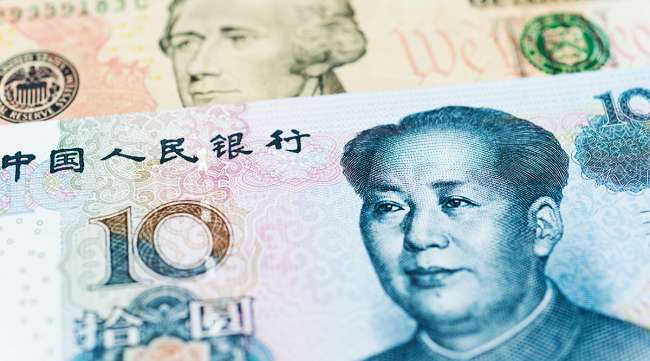China’s Counterpunch to Trump’s Tariffs Sparks Global Selloff

Tit-for-tat tariff threats from the United States and China ignited fears that a trade war is beginning between the world’s two largest economies, lowering U.S. stock futures.
President Donald Trump pushed back against an escalation with the Asian superpower, saying on Twitter that “we are not in a trade war with China, that war was lost many years ago by the foolish, or incompetent, people who represented the U.S.”
RELATED: Dow drops more than 400 points after being down 700 as trade-war fears intensify
China on April 4, matching the scale of proposed U.S. tariffs announced the previous day, said it would levy an additional 25% on an estimated $50 billion of U.S. imports including soybeans, automobiles, chemicals and aircraft.
The step escalates the risk of a trade war between the world’s two largest trading nations, with the Trump administration’s latest offensive based on alleged infringements of intellectual property in China. While the dispute centers on the $375 billion goods trade imbalance in favor of China in 2017, the United States also is targeting high-tech sectors that Beijing sees as the future for its economy, prompting an angry reaction.
RELATED: China urges more trade talks as tariffs on US goods begin
“China’s response was tougher than what the market was expecting — investors didn’t foresee the country levying additional tariffs on sensitive and important products such as soybeans and airplanes,” said Gao Qi, Singapore-based strategist at Scotiabank. “Investors believe a trade war will hurt both countries and their economies eventually.”
Beijing’s proposed targets strike at the core of commercial relations between the countries, and at some of the most politically sensitive goods in core Trump constituencies. For example, China is the world’s largest soybean importer and biggest buyer of U.S. soybeans in trade worth about $14 billion last year.
Both sides have calibrated their current actions around the figure of $50 billion worth of imports — the U.S. estimate of the annual damage to the domestic economy caused by China’s intellectual-property infringements. That number accounts for about one-third of China’s imports from the United States last year, versus less than one-tenth of China’s exports to the United States, according to data from International Monetary Fund.
RELATED: Trump’s trade war and the $470 billion hit to the global economy
The implementation date of China’s retaliatory tariffs depends on the outcome of bilateral negotiations, and the U.S. decisions, Deputy Finance Minister Zhu Guangyao, told reporters after a news conference in Beijing. “Now both sides have put up our lists. We believe both countries have the ability and wisdom to address the problem,” Zhu said.
U.S. Commerce Secretary Wilbur Ross said China’s response isn’t expected to disrupt the U.S. economy. In an interview on CNBC on April 4, he said China’s reaction “shouldn’t surprise anyone” as it’s proportionate to the U.S. action. China’s tariffs amount to about 0.3 percentage point of U.S. gross domestic product, “so it’s hardly a life-threatening activity,” he said.
Ross said the United States isn’t entering “World War III” and left the door open for a negotiated solution. “Even shooting wars end with negotiations,” he said.
The U.S. list of planned charges on more than 1,300 product categories focused on China’s industrial machinery and technology exports. China’s envoy to the World Trade Organization, Zhang Xiangchen, called it “an intentional and gross violation of the WTO’s fundamental principles of nondiscrimination and bound tariffs.”
Industries including aerospace, information and communications technology, robotics and machinery were among those targeted by the U.S. Trade Representative on April 3. The agency said it chose products to minimize the impact on the U.S. economy and consumers.
Besides advanced technologies such as communication satellites, the U.S. list includes items ranging from various types of steel to television components, medical devices, dishwashers, snow blowers and even flame throwers.
Trumped-Up Tariffs
Industrial technology categories dominate the USTR’s planned list of 1,333 tariff items.
“The U.S. list suggests that the government is targeting the ‘Made in China 2025’ initiative, while China’s retaliation intends to bring Americans back to the negotiation table,” Zhou Hao, an economist at Commerzbank AG in Singapore, said in an e-mail.
The release of the list by U.S. Trade Representative Robert Lighthizer leads into about a 60-day period when the public can provide feedback and the government holds hearings on the tariffs. The 25% tariffs come on top of any existing levies.
China’s Made in China 2025 plan was announced in 2015, and highlighted 10 sectors for support on the way to China becoming an advanced manufacturing power, from information technology to robotics and aerospace. China also has a separate development strategy for artificial intelligence, published last year.
“The current tariff measures from both parties are very unlikely to be implemented,” said Ren Qing, a partner at Global Law in Beijing who has advised the Chinese government on its response to the intellectual-property investigation. “People from American industries may exert pressure on the U.S. government and influence final policy implementation.”
With assistance by Miao Han, Kevin Hamlin, Eric Martin, Katia Dmitrieva, Henry Hoenig, Tian Chen, Xiaoqing Pi, Bryce Baschuk, Andrew Mayeda, Keith Zhai, and Matt Turner




